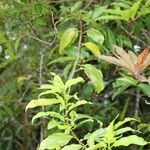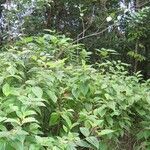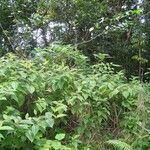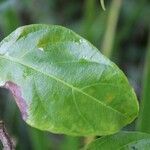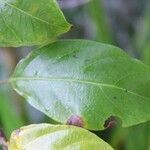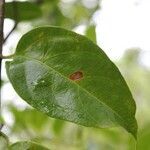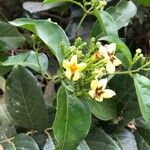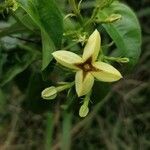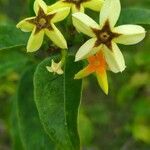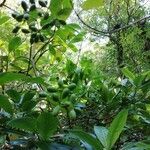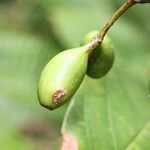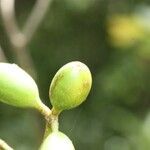Corolla with greenish-yellow tube and pale to bright yellow lobes with a distinctive star of orange-red hairs at the centre which become brownish-chocolate at maturity; tube 1.3–2.7 cm long, 2.5–5 mm wide at the top and 0.75–1.5 mm wide at the base, glabrous, hairy all over or with the hairs concentrated into 5 vertical stripes outside, with flattened yellow hairs at the throat and between the anthers, becoming glabrous towards the base within; lobes 4–19 × 2.5–11 mm, lanceolate to broadly ovate, acute to apiculate at apex, shortly connate for (0)1.5–3 mm.
Calyx tube 2–4 mm long, turbinate to ellipsoid, usually glabrous but occasionally sparsely hairy; lobes 0.7–1.5 × 0.25–2.5 mm, dentate, linear or slightly spathulate, curving outwards when mature, usually caducous; occasionally tending to produce a rudimentary creamy-white calycophyll (most developed in specimens from the Zambia N: division of the Flora Zambesiaca area), never as large as the leaves.
A shrub. It grows 2-3 m high. It can be a creeper 8-10 m long. The stems can be 12 cm across. The leaves are broadly oval. They are leathery and shiny. The flowers are yellow and tube shaped. They have a scent. The sepals are red and pointed and slightly downy. The fruit are almost round. They are edible.
Leaf blades 3–16.3(20) × 1.3–8.5(10.8) cm, elliptic to round, acuminate to caudate at the apex, cuneate, acute or rounded at the base, with 5–7 pairs of lateral nerves, coriaceous, glabrous above and glabrous or sparsely pubescent beneath with the nerves densely hairy; petiole 0.3–2.2 cm long.
Flowers isostylous or heterostylous, sweet-scented, in dense, lax or few-flowered panicles, terminal on short lateral branches (in climbing specimens); peduncles 0.8–4 cm long; secondary peduncles often present; pedicels 0–5.3(7) mm long.
Distance from the throat to the top of the anthers 0–1.6 mm in isostylous flowers (both stigma and anthers near the throat), 0–3 mm in short-styled flowers and 4–6 mm in long-styled flowers.
Style 1.2–2.1 cm in long-styled and isostylous flowers and 0.75–1 cm long in short-styled flowers; arms 0(1.3–2) mm long; stigma entirely exserted or included; lobes 2.2–5.2 mm long.
Shrub, scandent shrub or climber, 0.6–7(14) m tall; branches usually glabrous but often covered with shortish spreading hairs, said to exude a watery to milky or sticky sap.
Stipules 3–12 mm long, with lobe entire or divided almost to the base, reflexing and soon caducous revealing a line of red to brown hairs above the scar.
Fruit edible, pale green to yellow, (0.8)1.1–2.5 × (0.6)0.8–1.8 cm, ellipsoid or subglobose, with a round whitish scar at the apex.
Seeds 1–1.3 mm long, straw-coloured to pale brown, ± rectangular or triangular, slightly thickened, clearly reticulated.
Bracts and bracteoles entire or rarely 2–3 lobed, 0.2–2.7 cm long and up to 2 mm wide.
